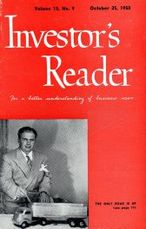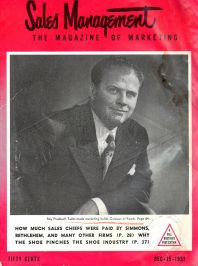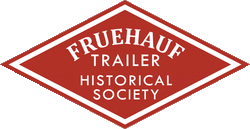Selected Historical Press on Fruehauf Trailer
BUSINESS WEEK APRIL 7, 1951

A CLOSE CALL FOR FRUEHAUF
The following article appeared in Business Week, April 7, 1951.
When Lustron folded, Fruehauf was nearly out $3-million owed it on 800 special trailers it built for Lustron’s trucker. But it plans to convert and resell the trailers without losing a cent.
Not too long ago, the name Lustron was full of promise. With its radical process for mass-producing prefab houses of porcelain-enameled steel, the new company looked to a lot of people as though it could lick the postwar housing shortage almost singlehanded. Housing Administrator Wilson Wyatt gave it his blessing. So did Reconstruction Finance Corp.—to the tune, finally, of $37.5-million.
And so, in a way, did Roy Fruehauf, burly, young president of Fruehauf Trailer Co. Fruehauf took a $4.5-million order to supply Lustron with 800 specially designed trailers. When Lustron folded, Fruehauf found itself with a whole fleet of trailers on its hands—good for nothing but carrying prefab houses—and most of them unpaid for. CONTINUED...Click HERE
The following article appeared in Business Week, April 7, 1951.
When Lustron folded, Fruehauf was nearly out $3-million owed it on 800 special trailers it built for Lustron’s trucker. But it plans to convert and resell the trailers without losing a cent.
Not too long ago, the name Lustron was full of promise. With its radical process for mass-producing prefab houses of porcelain-enameled steel, the new company looked to a lot of people as though it could lick the postwar housing shortage almost singlehanded. Housing Administrator Wilson Wyatt gave it his blessing. So did Reconstruction Finance Corp.—to the tune, finally, of $37.5-million.
And so, in a way, did Roy Fruehauf, burly, young president of Fruehauf Trailer Co. Fruehauf took a $4.5-million order to supply Lustron with 800 specially designed trailers. When Lustron folded, Fruehauf found itself with a whole fleet of trailers on its hands—good for nothing but carrying prefab houses—and most of them unpaid for. CONTINUED...Click HERE
INVESTOR'S READERS-October 25, 1950
PRODUCTION PERSONALITIES
Transportation – Fruehauf of Fruehauf The following interview appeared in the business magazine Investor’s Reader, October 25, 1950. Like 190-pound president Roy Fruehauf, Detroit’s $75,000,000 Fruehauf Trailer Company this week was in fighting trim. Thus far in 1950 the company has paid off $800,000 in debentures, has bought and retired close to 3,300 shares of $4 preferred (“we’re still buying it”) and put $1,000,000 into a bad debt reserve. When 1950 results are tallied, sales will be a smashing $140,000,000 or double last year and $56,000,000 above the company’s previous peak in 1948. Full year earnings should hit $9,000,000 ($7.00 a common share) compared to $2,800,000 ($1.91 a share) in 1949 and $5,500,000 ($4.16 a share) the year before that. Sums up Roy Fruehauf simply: “We are in the best competitive position we have ever been in.” One factor in this astounding gain is the current zip in general business contrasted to the doldrums of early 1949. This is especially true of the trailer business. These days Fruehauf has practically no inventories (except raw materials, of course) and a $30,000,000 backlog of orders. Comments Roy Fruehauf who is a hard-headed realist: “I never get excited about backlogs. My credit department has been checking and rechecking these orders to make sure we aren’t getting any wind. Thus far they seem OKay.” Continued CLICK HERE FOR MORE |
TIDE, November 3, 1950
SERVICE SELLING PAYS OFF
How Fruehauf become the giant of the truck-trailer industry The following cover story appeared in the November 3, 1950 issue of TIDE – The Newsmagazine for Advertising Executives. In the past 10 years, the company has more than quadrupled sales, will double 1949’s total this year. The report tells how the record was achieved and why the company’s future looks even better than its past. As good a way as any to assess the economic importance of the Fruehauf Trailer Co. is to examine the industry it serves. One source of light is a pocket sized handbook, American Trucking-Economic Giant, put out by the American Trucking Assn., Inc. (Washington), a national federation of 52 state and local associations. The organization is partisan, of course, and its interpretations and conclusions are constantly challenged by the railroads. But the figures it quotes come from unimpeachable sources. As presented in the booklet, the figures form a skein of fascinating irrelevancies typical of the way in which an industry association tells its story. For instance, the 8,000,000 motor trucks and trailers in the U.S., lined up bumper to bumper, would form a line 22,700 miles long. These vehicles provide direct employment for over 5,000,000 workers, “three and a half times as many jobs as the huge railroad industry.” They pay over $1 billion a year in special highway taxes, “more than the total spent by all states for new roads in 1948.” The 8.5 billion gallons of gas they consume each year, packed in gallon cans, would make five stacks that reach to the moon. The annual production of new units requires tremendous quantities of raw materials from every state – copper, steel, iron, lumber, paint, aluminum, lead, glass and rubber (“enough to make every man in the U.S. a new raincoat, hat and overshoes”). For more CLICK HERE |
Sales Management December 15, 1951
TAILORED-TO-MARKET METHODS - BUILD COLOSSUS OF ROADS
The following article, written by Lawrence M. Hughes, appeared in Sales Management – The Magazine of Marketing, December 15, 1951. By making products and promotion fit the widely-varying needs of all industries, and helping them all to expand, Fruehauf builds $160 million annual trailer sales volume. Ahead of the truck came the trailer. Two years before the first motor truck took to the road—for our Army in World War I—the new Fruehauf Trailer Co. of Detroit had sold the first trailer to a lumber business, which harnessed it to a Model T coupe. This original trailer was developed by August Fruehauf, blacksmith and wagonmaker. But his oldest son Harvey saw wider possibilities. It was Harvey who persuaded his dad to run a $50 advertisement, in American Lumberman. By such devices the company sold, in 1915, some $22,000 of the new contraptions. By 1920, when the company moved to its present headquarters out on Harper Avenue, business paper advertising had helped to push the volume to $700,000, on the slogan: “A horse can pull more than he can carry—so can a motor truck.” Already various vested interests were getting riled. The horses, of course, would rather tote than be turned into fertilizer. The truck makers didn’t, and don’t, like the claim that, even under state restrictions on trailer sizes and weights, a truck with a trailer can haul three times as much. And the railroads have been charged with inspiring much legislation and propaganda to “control” truck-trailers. Gradually, haulers learned that motorized transport is more flexible and for many purposes more economical. It can go anywhere there’s a road and some places where there isn’t. And while the railroads still rail, truck-trailers now haul more of more things, for more industries and businesses, to more places—including 25,000 villages and towns in this country which aren’t even reached by a single railroad line. Today, August’s three sons, Harvey, Harry and Roy, have the help of 8,500 employes [sic], including 450 salesmen, in turning out from seven factories and selling through 87 factory branches, trailers and trappings to the tune of $160 million a year. FOR MORE CLICK HERE |

